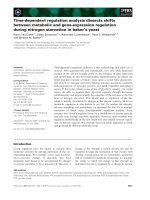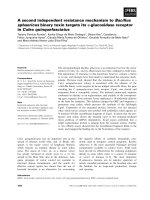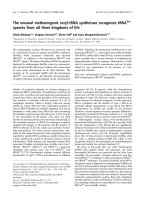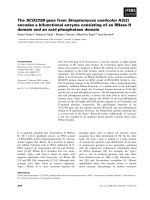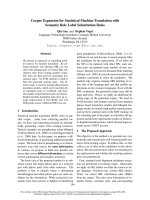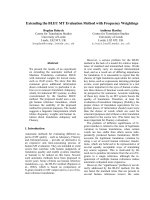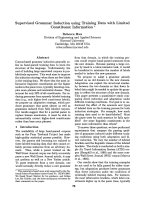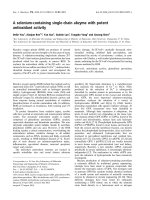Báo cáo khoa học: " Accelerated high-dose radiotherapy alone or combined with either concomitant or sequential chemotherapy; treatments of choice in patients with Non-Small Cell Lung Cancer" pps
Bạn đang xem bản rút gọn của tài liệu. Xem và tải ngay bản đầy đủ của tài liệu tại đây (681.67 KB, 10 trang )
BioMed Central
Page 1 of 10
(page number not for citation purposes)
Radiation Oncology
Open Access
Short report
Accelerated high-dose radiotherapy alone or combined with either
concomitant or sequential chemotherapy; treatments of choice in
patients with Non-Small Cell Lung Cancer
Apollonia LJ Uitterhoeve*
1
, Mia GJ Koolen
2
, Rob M van Os
1
,
Kees Koedooder
1
, Marlou van de Kar
1
, Bradley R Pieters
1
and
Caro CE Koning
1
Address:
1
Department of Radiation Oncology, Academic Medical Center/University of Amsterdam, Amsterdam, The Netherlands and
2
Department
of Pulmonary Disease, Academic Medical Center/University of Amsterdam, Amsterdam, The Netherlands
Email: Apollonia LJ Uitterhoeve* - ; Mia GJ Koolen - ; Rob M van
Os - ; Kees Koedooder - ; Marlou van de Kar - ;
Bradley R Pieters - ; Caro CE Koning -
* Corresponding author
Abstract
Background: Results of high-dose chemo-radiotherapy (CRT), using the treatment schedules of EORTC study
08972/22973 or radiotherapy (RT) alone were analyzed among all patients (pts) with Non Small Cell Lung Cancer
(NSCLC) treated with curative intent in our department from 1995–2004.
Material: Included are 131 pts with medically inoperable or with irresectable NSCLC (TNM stage I:15 pts, IIB:15
pts, IIIA:57 pts, IIIB:43 pts, X:1 pt).
Treatment: Group I: Concomitant CRT: 66 Gy/2.75 Gy/24 fractions (fx)/33 days combined with daily
administration of cisplatin 6 mg/m
2
: 56 pts (standard).
Group II: Sequential CRT: two courses of a 21-day schedule of chemotherapy (gemcitabin 1250 mg/m
2
d1, cisplatin
75 mg/m2 d2) followed by 66 Gy/2.75 Gy/24 fx/33 days without daily cisplatin: 26 pts.
Group III: RT: 66 Gy/2.75 Gy/24 fx/33 days or 60 Gy/3 Gy/20 fx/26 days: 49 pts.
Results: The 1, 2, and 5 year actuarial overall survival (OS) were 46%, 24%, and 15%, respectively.
At multivariate analysis the only factor with a significantly positive influence on OS was treatment with chemo-
radiation (P = 0.024) (1-, 2-, and 5-yr OS 56%, 30% and 22% respectively). The incidence of local recurrence was
36%, the incidence of distant metastases 46%.
Late complications grade 3 were seen in 21 pts and grade 4 in 4 patients. One patient had a lethal complication
(oesophageal). For 32 patients insufficient data were available to assess late complications.
Conclusion: In this study we were able to reproduce the results of EORTC trial 08972/22973 in a non-selected
patient population outside of the setting of a randomised trial. Radiotherapy (66 Gy/24 fx/33 days) combined with
either concomitant daily low dose cisplatin or with two neo-adjuvant courses of gemcitabin and cisplatin are
effective treatments for patients with locally advanced Non-Small Cell Lung Cancer. The concomitant schedule is
also suitable for elderly people with co-morbidity.
Published: 23 July 2007
Radiation Oncology 2007, 2:27 doi:10.1186/1748-717X-2-27
Received: 14 May 2007
Accepted: 23 July 2007
This article is available from: />© 2007 Uitterhoeve et al; licensee BioMed Central Ltd.
This is an Open Access article distributed under the terms of the Creative Commons Attribution License ( />),
which permits unrestricted use, distribution, and reproduction in any medium, provided the original work is properly cited.
Radiation Oncology 2007, 2:27 />Page 2 of 10
(page number not for citation purposes)
Background
Worldwide and in Europe lung cancer is the most com-
mon cause of cancer related-death with an increasing inci-
dence each year. The majority of patients has Non-Small
Cell Lung Cancer (NSCLC) and 75% has advanced disease
at the time of diagnosis. Since the mean age at diagnosis
is around 66 years it is often found in elderly patients with
co-morbidity [1-3].
Adaptation of our treatment policy has been guided by the
results of several subsequent EORTC studies in which we
participated. The results of EORTC 08844 indicated that
combination of radiotherapy with daily low-dose cispla-
tin is superior to radiotherapy alone or combined with
weekly cisplatin [4]. One of the criticisms of that study
was that the radiotherapy schedule was given as a split
course regimen up to 55 Gy.
In our institute a treatment schedule of 60 Gy in 3 Gy frac-
tions during 26 days using a concomitant boost technique
was investigated and appeared to be feasible [5]. A subse-
quent feasibility study showed that the split period, part
of the treatment regimen of EORTC-08844, could be left
out. This resulted in a radiotherapy schedule of 55 Gy,
given in 20 fractions in an overall treatment time (OTT) of
26 days, combined with daily cisplatin (6 mg/m
2
) [6]. In
EORTC-08912, the feasibility of increasing the radiother-
apy dose up to 66 Gy in 24 fractions of 2.75 Gy using a
concomitant boost technique was demonstrated. Every
radiotherapy fraction was preceded by administration of
cisplatin 6 mg/m
2
[7]. The standard radiotherapy dose in
combination therapy evolved thus from a dose of 55 Gy
split course in 1995 to 66 Gy continuously in 1997.
Since 1997 we have participated in EORTC-08972/22973.
In this trial sequential versus concurrent radio-chemo-
therapy has been studied [8]. The radiotherapy in this
study consisted of 66 Gy given in 24 fractions of 2.75 Gy.
This was combined with chemotherapy, given either
sequentially as two neo-adjuvant courses of cisplatin and
gemcitabin or concomitantly with daily cisplatin (6 mg/
m
2
). For patients who did not participate in the EORTC
study, standard treatment was offered which was equal to
the concomitant treatment arm.
Radiotherapy as sole treatment was offered if combined
radio-chemotherapy was medically contra-indicated or if
patients refused this option. In this situation an alterna-
tive radiotherapy schedule was used sometimes (60 Gy in
20 fractions of 3 Gy) [5].
Treatment outcome for patients with locally advanced
irresectable or inoperable NSCLC treated between1995
and 2004 is analysed here in a retrospective study.
Methods
Between 1995 and 2004 131 patients with inoperable
NSCLC were accepted for accelerated radiotherapy with
curative intent.
All patients were staged by means of physical examina-
tion, haematological counts, renal and liver function tests,
chest X-rays and contrast-enhanced CT-scan of the thorax
and upper abdomen. Pathological diagnosis was obtained
by bronchoscopy or cytological puncture.
Pathological confirmation of involvement of mediastinal
nodes was obtained by cytological punction or mediasti-
noscopy.
Lung function tests and Carbon Monoxide Diffusion
Capacity (DLCO) were part of the routine work-up.
Bone-scan and CT-scan or MRI of the brain was performed
if metastases at these sites were suspected. 18 FDG PET
was introduced as a routine staging procedure in our clinic
in 2004. Therefore the vast majority of patients was not
staged by means of a PET scan.
To be eligible for high-dose radiotherapy with curative
intent patients had to fulfil the following criteria: inoper-
able or irresectable NSCLC, T1-4, N0-2, M0 [9], patholog-
ically proven NSCLC or clinical and radiological
suspicion for malignancy, and ECOG performance score
0–2. Patients with unexplained weight-loss of more than
5% in 3 months or 10% in 6 months were excluded.
If the forced expiratory volume at 1 second (FeV1) was
less than 1 litre or DLCO < 50%, eligibility depended on
the result of the radiotherapy planning Dose-Volume His-
togram of the lung. Decision-making was based upon the
mean lung dose according to the publication of Kwa et al
[10].
Patients were also excluded if the length of the oesopha-
gus receiving 66 Gy exceeded 12 cm according to EORTC-
08912 [7].
To be eligible for chemotherapy patients should have ade-
quate renal and cardiac function.
If renal and/or cardiac functions were suboptimal patients
could be accepted for daily low dose cisplatin administra-
tion.
Standard treatment consisted of high-dose radiotherapy
with concomitant daily low-dose cisplatin[7,8]. Some
patients received sequential chemo-radiation. If chemo-
therapy was contra-indicated or refused, radiotherapy was
offered as single modality.
Radiation Oncology 2007, 2:27 />Page 3 of 10
(page number not for citation purposes)
Patients with a superior sulcus tumour were discussed
with the thoracic surgeon after chemo-radiation. In
selected cases a resection was performed.
Radiotherapy
All patients were planned by means of a CT-scan in treat-
ment position.
The Gross Tumour Volume (GTV) was defined as the pri-
mary tumour and pathological lymph nodes with a short
axis > 10 mm on the CT-scan.
The Boost Planning Target Volume (BPTV) included the
GTV with a margin of 12–15 mm in the lung, depending
on the respiratory movements as seen under fluoroscopy
and 10 mm in the mediastinum. The Elective Planning
Target Volume (EPTV) encompassed the BPTV and the
first lymph node drainage group not considered as patho-
logical with a margin of 12 mm.
In general the EPTV was irradiated with two opposite ante-
rior-posterior and posterior-anterior conformal fields
(AP-PA). The dose administered was 40 Gy in 20 daily
fractions of 2 Gy.
All fractions were given 5 times a week.
The BPTV was irradiated with conformal fields. The daily
fraction dose to the BPTV was 2.75 Gy, given in 24 frac-
tions to a total dose of 66 Gy. For the first 20 fractions a
concomitant boost technique was used. The EPTV
received 2 Gy per fraction and an extra dose of 0.75 Gy
was given in the same session to the BPTV. The planned
overall treatment time (OTT) varied between 32 and 34
days. The dose was defined according to the ICRU 50
report [11]. The fractionation schedule in case of radio-
therapy only, consisted of 20 daily fractions of 3 Gy to a
total dose of 60 Gy with an overall treatment time of 26
to28 days.
The maximal dose to the spinal cord was 50 Gy in frac-
tions of 2 Gy or the equivalent dose.
The maximal length of the oesophagus irradiated to 40
Gy, and to 66 Gy, was 18 cm, and 12 cm, respectively.
All patients were treated with 10 MV photon beams.
Chemotherapy
Two schedules of chemotherapy were used. Concurrent
chemotherapy consisted of cisplatin (6 mg/m
2
intrave-
nously) administered 1–2 hours before each fraction of
radiotherapy. The planned total dose of cisplatin was 144
mg/m
2
. In the sequential schedule patients started with
chemotherapy consisting of two courses of gemcitabin
(1250 mg/m
2
on days 1 and 8 and cisplatin 75 mg/m
2
on
day 2). The second course started on day 22. The radio-
therapy was given 3 to 4 weeks after the last gemcitabin
dose, usually on day 57.
Toxicity
Late oesophageal toxicity and radiation pneumonitis were
scored according to the RTOG/EORTC criteria [12].
Statistical analysis
Local recurrence-free, distant recurrence-free, and overall
survival were calculated from the last day of radiotherapy.
Local recurrence was defined as a situation in which clin-
ical or radiological signs of tumour progression were
observed within the radiation portals. The Kaplan-Meier
method was used to estimate the probability of local
recurrence-free, distant recurrence-free and overall sur-
vival[13]. The log-rank test was used to test differences
between groups.
To evaluate association between prognostic factors and
overall survival a Cox proportional hazard analysis was
performed to obtain hazard ratio's (HR) and 95% confi-
dence intervals (CI). The prognostic factors that were eval-
uated were: sex, age (continuous), ECOG performance
score (0–1 vs. 2), pathology stage (I vs. II vs. III), radio-
therapy dose (55–60 Gy vs. > 60 Gy) and chemotherapy.
The prognostic factors were removed step by step from the
model using the Wald statistic to assess statistical signifi-
cance. A P-value equal to or < 0.05 was considered statis-
tically significant.
Three patients who did not finish radiotherapy and
received a dose less than 55 Gy were left out of the multi-
variate analysis.
Statistical analysis was performed with Statistical Package
for Social Sciences, version 12.0 (SPSS, Chicago, IL, USA).
Results
A total of 131 patients was treated with high-dose radio-
therapy with or without chemotherapy.
In 56 cases the radiotherapy was combined with concom-
itant cisplatin and in 26 cases with 2 courses of neo-adju-
vant cisplatin and gemcitabin. In total 49 patients
received radiotherapy without chemotherapy.
A summary of patient characteristics is presented in table
1. The mean age was 66 years (range 30–85). For patients
receiving concomitant chemo-radiation, sequential
chemo-radiation or radiation alone the mean age was 62,
61, and 71 years, respectively. Twenty patients have pre-
Radiation Oncology 2007, 2:27 />Page 4 of 10
(page number not for citation purposes)
sented with weight loss > 5% for which a possible not
tumour related cause was available. Only 4 patients had a
PET-scan for staging.
The FeV1 value was known for 119 patients, with a mean
of 77% (range 30–125%). The DLCO was available for 77
patients with a mean of 78% (range 30–121%).
Treatment characteristics
A summary of treatment parameters is presented in table
2.
One patient received a dose of 67.5 Gy for compensation
of a split period.
For 25 patients the total dose to the BPTV was 60 Gy in
fractions of 3 Gy. One patient received 63 Gy in fractions
of 3 Gy for compensation of a split period.
For 5 patients a dose of 55 Gy in daily fractions of 2.75 Gy
was administered. For one patient the mean lung dose was
considered too high for a dose of 66 Gy, for another
patient the length of the oesophagus receiving a daily frac-
tion of 2.75 Gy was 14.3 cm which was judged too long
for a total dose of 66 Gy. For 3 patients it was not clear
why the maximal dose was reduced to 55 Gy. For three
other patients the dose given was below 50 Gy; in two
patients because of progressive distant disease and
another died during the treatment period for unknown
reasons.
Among 86 patients the Elective Planning Treatment Vol-
ume (EPTV) was irradiated to a dose of 40 Gy in fractions
of 2 Gy.
The mean overall treatment time (OTT) was 33 days
(range 21–57). In 29 patients the OTT ranged between
35–39 days. This was due to logistic reasons (holidays,
start on Thursday) in 21 patients, in five patients the treat-
ment was interrupted for acute side effects and in three
patients the reason for interruption was not clear. In 5
patients the OTT was between 43 and 57 days, in two
patients the treatment was interrupted because of
oesophagitis, in three patients due to infection.
Two patients of group II showed progressive disease dur-
ing induction chemotherapy. They received the radiother-
apy as planned and were evaluated within this group.
Survival
The median follow-up was 10.5 months. The 1, 2, and 5-
year survival rates were 46%, 24%, and 15% respectively
(fig 1). Disease-free survival at 1, 2, and 5 years was 38%,
30%, and 25%, respectively.
The absolute incidence of a local recurrence was 36%, the
incidence of distant metastases 46%. Local relapse-free
interval at 1, 2, and 5 years was 64%, 56%, and 47%,
respectively (fig 2). In 23 of the 131 patients no reliable
data concerning a local relapse could be obtained. Distant
relapse-free interval at 1, 2 and 5 years was 61%, 49% and
46%, respectively (fig 3). The number of remaining
patients at 40 and 60 months is 10 and 5 respectively.
In 25 patients no reliable information about presence or
absence of distant relapse was available. Twenty patients
had a local as well as a distant relapse.
Table 2: Radiotherapy characteristics of 131 patients treated
with high-dose accelerated radiotherapy with or without
chemotherapy
Radiotherapy characteristics
Dose BPTV (Gy) number of patients
< 50 3
55 5
60 25
63 1
66 96
67 1
Overall Treatment Time (days)
<26 3
26–31 35
32–34 59
35–39 29
43–57 5
Table 1: Patient characteristics of 131 patients treated with high
dose accelerated radiotherapy with or without chemotherapy
Group
Patient characteristics Number of
patients
IIIIII
Total number 131 56 26 49
Male/female 89/42
mean age (years) 66 62 61 71
Elderly (>70 years) 55 16 7 32
Performance (ECOG scale)
0/1/2 28/76/27
Pathology
Adenocarcinoma 18
Squamous cell carcinoma 39
Large cell carcinoma 60
Undifferentiated carcinoma 8
No pathology 6
TNM stage
I/IIB 15/15 1/7 2/0 12/8
IIIA/IIIB 68/32 29/18 20/4 19/10
Unclassifiable 1 1
Radiation Oncology 2007, 2:27 />Page 5 of 10
(page number not for citation purposes)
Prognostic factors
Factors with a significantly favourable influence on over-
all survival were: chemo-radiotherapy (P = 0.01), per-
formance status 0 or 1 (P = 0.04) and age < 58 years (P =
0.05). There was no statistically significant difference in
OS between the two means of chemotherapy administra-
tion. When separately analysed only concomitant chemo-
radiation yielded a significant survival benefit, compared
to radiotherapy as single modality (median survival time
13.4 months (95% CI 10.7 to 16.1) vs. 9.4 months (95%
CI 7.5 to 11.4); P = 0.01; figure 4). Patients receiving only
radiotherapy were older and had more often an ECOG
performance score more than 1.
At multivariate analysis only treatment with chemo-radia-
tion was left as a prognostic factor for OS (P = 0.024). The
HR for OS of sequential compared to concurrent chemo-
therapy was 1.18 (95% CI 0.65 to2.13; P = 0.583), and for
no chemotherapy vs. concurrent chemotherapy 1.84
(95% CI 1.17 to2.88; P = 0.08). The radiation dose had no
influence on the survival, irrespective of the treatment
modality. The improved OS of chemo-radiation was
apparent in patients up to 70 years as well as in patients >
70 years. Disease-free survival (DFS) at 5 years for patients
who had received concomitant radio-chemotherapy was
30%. This was superior to the 5 years DFS for patients
treated with sequential radio-chemotherapy (20%) and
for the group treated with radiotherapy alone (18%), but
the differences were not statistically significant. Age and
stage had no influence on DFS.
For local relapse-free interval no influence of treatment
modality could be seen. Distant metastasis-free interval
was improved in patients treated with concurrent chemo-
radiation, but the difference was not significant.,
At the moment of analysis 32 patients were alive. Fifteen
patients had survived more than 36 months. Two under-
went a lobectomy after the end of radiotherapy.
Toxicity
For 19 patients data to assess late toxicity were not suffi-
ciently available; for 13 patients the follow-up period was
too short. Thus data about late toxicity are available for 99
patients (table 3).
The four patients with late grade 4 toxicity were all treated
with concurrent chemo-radiation. One patient died of
uncontrolled complications of an oesophageal fistula. In
this patient, with very extensive mediastinal nodal dis-
ease, the oesophagus was irradiated over a length of 14.3
cm to 66 Gy. Severe late toxicity was more frequent in
Local-recurrence free interval for 131 patients treated with accelerated high-dose radiotherapy with or without chemo-therapyFigure 2
Local-recurrence free interval for 131 patients treated with
accelerated high-dose radiotherapy with or without chemo-
therapy.
Actuarial overall survival of 131 patients treated with high dose accelerated radiotherapy with or without chemother-apyFigure 1
Actuarial overall survival of 131 patients treated with high
dose accelerated radiotherapy with or without chemother-
apy.
Radiation Oncology 2007, 2:27 />Page 6 of 10
(page number not for citation purposes)
patients treated with concurrent or sequential chemo-
radiation (27% and 23% respectively) than in patients
treated with radiotherapy only (8%).
Overall, severe late toxicity grade 3 did not occur more fre-
quently in elderly patients. In the group of patients treated
with concurrent chemo-radiation 9 out of 40 patients < 70
years presented severe late toxicity (23%); 5 of the 16 eld-
erly patients in this group had severe late toxicity (31%).
All patients presenting late toxicity grade 4 were younger
than 70 years.
Discussion
Our overall survival rates are in accordance with recently
published results by other authors [8,14-22]. Survival in
our series is significantly better among patients treated
with a combination of chemo- and radiotherapy which is
the only prognostic factor in multivariate analysis. An
effect of selection bias cannot be ruled out, since concom-
itant chemo-radiation was standard treatment in our
department. At the interpretation of the data we must be
aware of the large number of censored patients after 40
months.
No significant difference in survival between concomitant
and sequential administration of chemotherapy is
observed in our series. The optimal way of combining
chemotherapy with radiation is studied in several phase
III studies and a meta-analysis is underway. These studies
indicate that concurrent administration of chemotherapy
and radiotherapy is superior to sequential administration
Table 3: Late toxicity for 131 patients treated with high-dose accelerated radiotherapy with or without chemotherapy
Late toxicity (RTOG/EORTC)
Grade 0 1–2 3 4 not evaluable unknown
Number of
patients
66 8 21* 4** 13 19
Group I 293114 2 7
Group II 1016036
Group III2744086
* pulmonary 17, oesophageal 3, cardiac 1
** pulmonary 1, oesophageal 2 (1 lethal), neuropathy 1
Distant-metastasis free interval for 131 patients treated with accelerated high-dose radiotherapy with or without chemo-therapyFigure 3
Distant-metastasis free interval for 131 patients treated with
accelerated high-dose radiotherapy with or without chemo-
therapy.
Actuarial overall survival of patients treated with high-dose accelerated radiotherapy with concomitant chemotherapy, with sequential chemotherapy or without chemotherapyFigure 4
Actuarial overall survival of patients treated with high-dose
accelerated radiotherapy with concomitant chemotherapy,
with sequential chemotherapy or without chemotherapy.
Radiation Oncology 2007, 2:27 />Page 7 of 10
(page number not for citation purposes)
[15-18,22-25]. The Locally Advanced Multi-Modality Pro-
tocol also demonstrated the superiority of concurrent CRT
[26]. EORTC study 08972/22973 was underpowered to
detect a significant difference between concurrent and
sequential chemo-radiotherapy, but showed good results
in both arms [8]. In the present study we were able to
reproduce the results of the EORTC trial in a non-selected
patient population outside of the setting of a randomised
trial. In our series the 5-year overall survival is 23% for the
concomitant CRT schedule, which is comparable to the 5-
year survival data of concomitant chemo-radiotherapy of
others [17,18,22]. Curran et al. do not report 5-year over-
all survival data, but a 2-year survival rate of 37% for
patients treated concomitantly, which is somewhat higher
than in our series [16]. All of these studies followed plati-
num-based multi-agent standard chemotherapy sched-
ules with higher cumulative doses of cisplatin than in our
study except for the EORTC trial.
There is no convincing evidence that concomitant stand-
ard poly-chemotherapy is superior to daily low-dose cispl-
atin alone, if it is combined with a high radiation dose. In
one trial addition of concomitant cisplatin (daily 6 mg/
m
2
) showed no improvement, but the administered radi-
ation dose was only 45 Gy [27]. Carboplatin might be less
effective as a radiosensitizer for NSCLC, as several low-
dose single agent carboplatin studies were negative. A
two-drug combination (carboplatin plus etoposide) was
better than single agent only for carboplatin based trials
[27-34].
Epidemiological studies show that with increasing age the
percentage of people treated with chemotherapy and
chemo-radiation decreases and that treatment is an inde-
pendent prognostic factor while age does not play a role
in stage III and IV NSCLC [21,35-37]. Aupérin describes
an improved effect of chemo-radiation compared to radi-
ation alone for patients older than 60 years with disease
stage IIIB [27].
Can adjuvant chemotherapy improve survival? Recent tri-
als and a meta-analysis have shown that adjuvant chemo-
therapy given post-operatively improves survival [38-40].
In contrast, neo-adjuvant chemotherapy given before con-
comitant chemo-radiation does not improve prognosis
[26,41,42]. The data of Keene et al. also support the use of
adjuvant chemotherapy after chemo-radiation with a
daily low-dose of cisplatin [43].
Therefore adding adjuvant chemotherapy afterwards to
our standard treatment of 66 Gy together with a daily low-
dose of cisplatin might improve results.
Can accelerated radiotherapy improve results? The short
OTT of 33 days and the high Biological Equivalent Dose
(84 Gy for an α/β ratio of 10 Gy which is equivalent to a
dose of 70 Gy in fractions of 2 Gy) might have been a
favourable factor in our treatment outcome. In the
CHART-study reduction of the OTT from 6 weeks to 12
days resulted in improved outcome with radiotherapy
alone, indicating an influence of repopulation [44]. Sev-
eral other studies report about improved results while
shortening the OTT, for radiotherapy alone or for chemo-
radiation [18,45-47]. Assuming that accelerated repopula-
tion begins 28 days after start of treatment and that each
day of prolongation hereafter should be compensated by
0.5 Gy, 66 Gy administered in 32 days could be equiva-
lent to a BED
10
of 93 Gy [Dische 02, Hermann 04, Fowler
04].
Dose-relationship for local control and survival has been
clearly demonstrated for lung cancer [19]. In the
Cochrane analysis the superior effect of chemo-radiation
is independent of the radiation dose administered [24].
This suggests that increasing the radiation dose during
concomitant treatment schedules might have a positive
effect on local control, as was demonstrated by Socinsky
[21].
Keene, Schild and Jeremic have reported 5-year survival of
20–25% for treatment schemes consisting of high-dose
radiotherapy in a short OTT combined with daily admin-
istration of low-dose cisplatin (Keene, Schild) or concom-
itant poly-chemotherapy in a weekly schedule [36,43,48].
In our series some of the patients (non-PET-scan staged)
had stage I-IIB, but stage did not show any association
with survival among our patients treated with chemo-
radiation.
Performance status and age are well known as prognostic
factors for survival [21,35-37]. After correction for treat-
ment modality, the significance of age and performance
status disappears in our study.
Local recurrence-free and distant metastasis-free interval
are in agreement with other reported series [49]. The pres-
ence of a local recurrence in a retrospective analysis is
often difficult to determine. For local recurrence clinical
or radiological signs of progression within the radiation
portals had to be evident. A bronchoscopy to check pres-
ence or absence of local tumour was not performed as a
routine procedure and only done in a minority of the
patients. Besides, in a substantial number of patients reli-
able data about a local or distant relapse were missing.
Therefore these figures have to be regarded with caution.
The absence of information during follow-up in several
patients and the difficulty in interpretation of the local sit-
uation in others can explain the lack of significant influ-
Radiation Oncology 2007, 2:27 />Page 8 of 10
(page number not for citation purposes)
ence of treatment modality upon local relapse-free or
distant relapse-free interval.
Results of radiotherapy as single modality are disappoint-
ing, with a median survival of 10 months and a 2 year
actuarial survival of 15%. The administered radiation
dose is relatively high however (BED10 78 Gy–84 Gy).
Selection might partly explain this effect, while radiation
mono-therapy was advised if chemo-radiation was not
feasible. Higher doses are needed for improved survival.
Pilot studies of dose escalation yielded promising data
[19,50-53].
Results of patients presenting with ECOG performance
score of 2 are poor, the median survival is 8 months and
no one survived 2 years. We conclude that high dose radi-
otherapy with or without chemotherapy is not indicated
for this group of patients.
Toxicity
In our series the most severe late toxicity seems to be
related to the oesophagus. This is in agreement with data
in the literature of concomitant chemo-radiotherapy [24].
However, in EORTC study 08844 no increase in oesopha-
geal toxicity was observed after daily or weekly adminis-
tration of cisplatin [4]. The total dose of 55 Gy in this trial
was much lower however. Keene et al. conclude that the
addition of low-dose daily cisplatin 6 mg/m
2
to a radio-
therapy dose of 69.6 Gy, given in fractions of 1.2 Gy twice
daily, did not increase oesophageal toxicity [43]. On the
contrary Belderbos et al. conclude that chemo-radiation of
concomitant low-dose cisplatin increases the risk for acute
oesophageal toxicity [54]. A relationship between acute
and late oesophageal toxicity has been described by Singh
et al. and Ahn et al. [55,56]. Other factors which correlate
with the risk for oesophagitis are the absolute maximum
radiation dose, volume of the oesophagus receiving 35 Gy
ore more (V35) and the length of the irradiated oesopha-
gus [54-57]. In our treatment protocol the length of the
oesophagus receiving a dose of 66 Gy was restricted to 12
cm. In the patient with lethal late oesophageal toxicity the
normal tolerance was wittingly exceeded.
According to the RTOG/EORTC criteria 17 patients devel-
oped a severe radiation pneumonitis grade 3 for which
antibiotics and steroid treatment were given, but none of
them developed a respiratory insufficiency; therefore we
think that this toxicity is clinically acceptable. Decrease in
toxicity is possible by a reduction of the planning target
volume (PTV). If patients are staged with a PET-CT scan
elective treatment can be omitted and a better definition
of the GTV is possible. Both factors lead to a smaller PTV
[58].
Severe late toxicity was not observed more frequently in
elderly patients if treated with concurrent chemo-radia-
tion. In our experience patients with suboptimal renal or
cardiac function, as is often the case in elderly and frail
patients, can still be eligible for administration of low-
dose cisplatin, while standard poly-chemotherapy is not
possible. Besides, the incidence of severe haematological
toxicity of chemo-radiation with daily low dose cisplatin
is low and this treatment can be given on an out-patient
base [8,19]. Therefore we conclude that this schedule a
good option for elderly people.
Furthermore the toxicity profile of this schedule makes it
suitable for combination with biological response modi-
fiers as for instance cetuximab, which has proven activity
if combined with radiotherapy and which is tested in
phase II and III trials in combination with chemo-radia-
tion in Head and Neck cancer [59,60].
In conclusion: implementation of the treatment schedule
used in EORTC study 08972/22973 in a non-randomised
setting resulted in comparable outcome in our depart-
ment. Treatment of patients with locally advanced NSCLC
with concomitant chemo-radiation led to an actuarial 5-
year survival of 23%. This was obtained with a radiation
dose of 66 Gy, given in 24 fractions within a short overall
treatment time and administration of single agent daily
cisplatin 6 mg/m
2
. Toxicity of this treatment scheme is
acceptable, if constraints are made for the volume of the
irradiated oesophagus and the lungs. An important find-
ing in this era of increasing age is that this treatment
scheme is also feasible for elderly patients with a subopti-
mal renal and/or cardiac function. Thus, the preferred
standard treatment of patients with locally advanced
NSCLC in our department remained concomitant chemo-
radiation with a low dose of daily cisplatin. Furtherways
for improvement are escalation of the radiotherapy dose
and/or reduction of the overall treatment time by acceler-
ation and hyper-fractionation among patients staged by
PET-CT, combination of accelerated and hyper-fraction-
ated radiotherapy with concurrent chemotherapy, and
adjuvant chemotherapy. Other new modalities which are
under investigation are combinations of chemo-radiation
with biological response modifiers.
Competing interests
The author(s) declare that they have no competing inter-
ests.
Authors' contributions
All authors have contributed substantially to conception
and design, analysis and interpretation of data and to
drafting and revising the article.
All authors read and approved the final manuscript.
Radiation Oncology 2007, 2:27 />Page 9 of 10
(page number not for citation purposes)
References
1. Bray F, Tyczynski JE, Parkin DM: Going up or coming down? The
changing phases of the lung cancer epidemic from 1967 to
1999 in the 15 European Union countries. Eur J Cancer 2004,
40:96-125.
2. Janssen-Heijnen ML, Gatta G, Forman D, Capocaccia R, Coebergh
JW: Variation in survival of patients with lung cancer in
Europe, 1985-1989. EUROCARE Working Group. Eur J Cancer
1998, 34:2191-2196.
3. Jemal A, Siegel R, Ward E, Murray T, Xu J, Smigal C, Thun MJ: Cancer
statistics, 2006. CA Cancer J Clin 2006, 56:106-130.
4. Schaake-Koning C, W. B, Dalesio O, Festen J, Hoogenhout J, van HP,
Kirkpatrick A, Koolen M, Maat B, Nijs A, .: Effects of concomitant
cisplatin and radiotherapy on inoperable non-small-cell lung
cancer. N Engl J Med 1992, 326:524-530.
5. Schuster-Uitterhoeve AL, Hulshof MC, D. GG, Koolen M, Sminia P:
Feasibility of curative radiotherapy with a concomitant
boost technique in 33 patients with non-small cell lung can-
cer (NSCLC). Radiother Oncol 1993, 28:247-251.
6. Schuster-Uitterhoeve AL, Vaart , Schaake-Koning CC, Benraadt J,
Koolen MG, Gonzalez GD, Bartelink H: Feasibility of escalating
daily doses of cisplatin in combination with accelerated radi-
otherapy in non-small cell lung cancer. Eur J Cancer 1996,
32A:1314-1319.
7. Uitterhoeve AL, Belderbos JS, Koolen MG, van der Vaart P, Rodrigus
PT, Benraadt J, Koning CC, D. GG, Bartelink H: Toxicity of high-
dose radiotherapy combined with daily cisplatin in non-small
cell lung cancer: results of the EORTC 08912 phase I/II study.
European Organization for Research and Treatment of Can-
cer. Eur J Cancer 2000, 36:592-600.
8. Belderbos J, Uitterhoeve L, N. Z, Belderbos H, Rodrigus P, van V,
Price A, van WN, Legrand C, Dussenne S, Bartelink H, Giaccone G,
Koning C: Randomised trial of sequential versus concurrent
chemo-radiotherapy in patients with inoperable non-small
cell lung cancer (EORTC 08972-22973). Eur J Cancer 2007,
43:114-121.
9. TNM Classification of malignant tumours New York, Wiley-Liss; 2002.
10. Kwa SL, Lebesque JV, Theuws JC, Marks LB, Munley MT, Bentel G,
Oetzel D, Spahn U, Graham MV, Drzymala RE, Purdy JA, Lichter AS,
Martel MK, Ten Haken RK: Radiation pneumonitis as a function
of mean lung dose: an analysis of pooled data of 540 patients.
Int J Radiat Oncol Biol Phys 1998, 42:1-9.
11. ICRU BMD: Prescribing, recording and reporting photon
beam therapy. ICRU report 62 1999.
12. Cox JD, Stetz J, Pajak TF: Toxicity criteria of the Radiation
Therapy Oncology Group (RTOG) and the European Organ-
ization for Research and Treatment of Cancer (EORTC). Int
J Radiat Oncol Biol Phys 1995, 31:1341-1346.
13. Kaplan EL, Meier P: Nonparametric estimation from incom-
plete observations. J Am Stat Assoc 1958, 53:457-481.
14. Albain KS, Crowley JJ, Turrisi AT III, Gandara DR, Farrar WB, Clark
JI, Beasley KR, Livingston RB: Concurrent cisplatin, etoposide,
and chest radiotherapy in pathologic stage IIIB non-small-
cell lung cancer: a Southwest Oncology Group phase II
study, SWOG 9019. J Clin Oncol 2002, 20:3454-3460.
15. Curran W, Scott C, Langer C: Phase III comparison of sequential
versus concurrent chemoradiation for patients with unre-
sected stage III non-small cell lung cancer. Initial report of
Radiation Therapy Oncology Group (RTOG) 9410. Proc Am
Soc Clin Oncol 2000, 19:484a abstract 1891.
16. Curran W, Scott C, Langer C: Long-term benefit is observed in
a phase III comparison of sequential vs concurrent chemora-
diation for patients with unresected stage III nsclc: RTOG
9410. Proc Am Soc Clin Oncol 2003, 22:621.
17. Fournel P, Robinet G, Thomas P, Souquet PJ, Lena H, Vergnenegre A,
Delhoume JY, Le TJ, Silvani JA, Dansin E, Bozonnat MC, Daures JP,
Mornex F, Perol M: Randomized phase III trial of sequential
chemoradiotherapy compared with concurrent chemoradi-
otherapy in locally advanced non-small-cell lung cancer:
Groupe Lyon-Saint-Etienne d'Oncologie Thoracique-
Groupe Francais de Pneumo-Cancerologie NPC 95-01
Study. J Clin Oncol 2005, 23:5910-5917.
18. Furuse K, Fukuoka M, Kawahara M, Nishikawa H, Takada Y, Kudoh S,
Katagami N, Ariyoshi Y: Phase III study of concurrent versus
sequential thoracic radiotherapy in combination with mito-
mycin, vindesine, and cisplatin in unresectable stage III non-
small-cell lung cancer. J Clin Oncol 1999, 17:2692-2699.
19. Martel MK, Ten Haken RK, Hazuka MB, Kessler ML, Strawderman M,
Turrisi AT, Lawrence TS, Fraass BA, Lichter AS: Estimation of
tumor control probability model parameters from 3-D dose
distributions of non-small cell lung cancer patients. Lung Can-
cer 1999, 24:31-37.
20. Sause W, Kolesar P, IV TS, Johnson D, Livingston R, Komaki R, Emami
B, Curran W Jr., Byhardt R, Dar AR, Turrisi A III: Final results of
phase III trial in regionally advanced unresectable non-small
cell lung cancer: Radiation Therapy Oncology Group, East-
ern Cooperative Oncology Group, and Southwest Oncology
Group. Chest 2000, 117:358-364.
21. Socinski MA, Zhang C, Herndon JE, Dillman RO, Clamon G, Vokes E,
Akerley W, Crawford J, Perry MC, Seagren SL, Green MR: Com-
bined modality trials of the Cancer and Leukemia Group B
in stage III non-small-cell lung cancer: analysis of factors
influencing survival and toxicity. Ann Oncol 2004, 15:1033-1041.
22. Zatloukal P, Petruzelka L, Zemanova M, Havel L, Janku F, Judas L,
Kubik A, Krepela E, Fiala P, Pecen L: Concurrent versus sequen-
tial chemoradiotherapy with cisplatin and vinorelbine in
locally advanced non-small cell lung cancer: a randomized
study. Lung Cancer 2004, 46:87-98.
23. Movsas B, Scott C, Sause W, Byhardt R, Komaki R, Cox J, Johnson D,
Lawton C, Dar AR, Wasserman T, Roach M, Lee JS, Andras E: The
benefit of treatment intensification is age and histology-
dependent in patients with locally advanced non-small cell
lung cancer (NSCLC): a quality-adjusted survival analysis of
radiation therapy oncology group (RTOG) chemoradiation
studies. Int J Radiat Oncol Biol Phys 1999, 45:1143-1149.
24. Rowell NP, O'Rourke NP: Concurrent chemoradiotherapy in
non-small cell lung cancer (Review). In The Cochrane Library Vol-
ume 1. Wiley; 2005:1-37.
25. Vokes EE: Optimal therapy for unresectable stage III non-
small-cell lung cancer. J Clin Oncol 2005, 23:5853-5855.
26. Belani CP, Choy H, Bonomi P, Scott C, Travis P, Haluschak J, Curran
WJ Jr.: Combined chemoradiotherapy regimens of paclitaxel
and carboplatin for locally advanced non-small-cell lung can-
cer: a randomized phase II locally advanced multi-modality
protocol. J Clin Oncol 2005, 23:5883-5891.
27. Auperin A, Le PC, Pignon JP, Koning C, Jeremic B, Clamon G, Einhorn
L, Ball D, Trovo MG, Groen HJ, Bonner JA, T. LC, Arriagada R: Con-
comitant radio-chemotherapy based on platin compounds in
patients with locally advanced non-small cell lung cancer
(NSCLC): a meta-analysis of individual data from 1764
patients. Ann Oncol 2006, 17:473-483.
28. Ball D, Bishop J, Smith J, O'Brien P, Davis S, Ryan G, Olver I, Toner
G, Walker Q, Joseph D: A randomised phase III study of accel-
erated or standard fraction radiotherapy with or without
concurrent carboplatin in inoperable non-small cell lung can-
cer: final report of an Australian multi-centre trial. Radiother
Oncol 1999, 52:129-136.
29. Clamon G, Herndon J, Cooper R, Chang AY, Rosenman J, Green MR:
Radiosensitization with carboplatin for patients with unre-
sectable stage III non-small-cell lung cancer: a phase III trial
of the Cancer and Leukemia Group B and the Eastern Coop-
erative Oncology Group. J Clin Oncol 1999, 17:4-11.
30. Gervais R, Ducolone A, Le Chevalier T, et.al.: Conventional radia-
tion (RT) with daily carboplatin (Cb) compared to RT alone
after induction chemotherapy (ICT). (vinorelbine (Vt)-cispl-
atin (p): final results of a randomized phase III trial in stage
III unresectable non small cell lung (NSCLC) cancer. J Clin
Oncol 2005, 23 16S:.
31. Groen HJ, van der Leest AH, Fokkema E, Timmer PR, Nossent GD,
Smit WJ, Nabers J, Hoekstra HJ, Hermans J, Otter R, van Putten JW,
de Vries EG, Mulder NH: Continuously infused carboplatin used
as radiosensitizer in locally unresectable non-small-cell lung
cancer: a multicenter phase III study. Ann Oncol 2004,
15:427-432.
32. Huber R, Schmidt M, Flentje M, et.al.: Induction chemotherapy
and following simultaneous radio/chemotherapy versus
induction chemotherapy and radiotherapy alone in operable
NSCLC (stage IIIA/IIIB). Proc Am Soc Oncol 2003, 22:22a:.
33. Jeremic B, Shibamoto Y, Acimovic L, Djuric L: Randomized trial of
hyperfractionated radiation therapy with or without concur-
Radiation Oncology 2007, 2:27 />Page 10 of 10
(page number not for citation purposes)
rent chemotherapy for stage III non-small-cell lung cancer. J
Clin Oncol 1995, 13:452-458.
34. Jeremic B, Shibamoto Y, Acimovic L, Milisavljevic S: Hyperfraction-
ated radiation therapy with or without concurrent low-dose
daily carboplatin/etoposide for stage III non-small-cell lung
cancer: a randomized study. J Clin Oncol 1996, 14:1065-1070.
35. Janssen-Heijnen ML, Smulders S, Lemmens VE, Smeenk FW, van Gef-
fen HJ, Coebergh JW: Effect of comorbidity on the treatment
and prognosis of elderly patients with non-small cell lung
cancer. Thorax 2004, 59:602-607.
36. Schild SE, Wong WW, Vora SA, Halyard MY, Northfelt DW, Kogut
HL, Wheeler RH: The long-term results of a pilot study of
three times a day radiotherapy and escalating doses of daily
cisplatin for locally advanced non-small-cell lung cancer. Int J
Radiat Oncol Biol Phys 2005, 62:1432-1437.
37. Werner-Wasik M, Scott C, Cox JD, Sause WT, Byhardt RW, Asbell
S, Russell A, Komaki R, Lee JS: Recursive partitioning analysis of
1999 Radiation Therapy Oncology Group (RTOG) patients
with locally-advanced non-small-cell lung cancer (LA-
NSCLC): identification of five groups with different survival.
Int J Radiat Oncol Biol Phys 2000, 48:1475-1482.
38. Sedrakyan A, J. M, O'Byrne K, Prendiville J, Hill J, Treasure T: Post-
operative chemotherapy for non-small cell lung cancer: A
systematic review and meta-analysis. J Thorac Cardiovasc Surg
2004, 128:414-419.
39. The International Adjuvant Lung Cancer Collaborative Trial Group:
Cisplatin-based adjuvant chemotherapy in patients with
completely resected non-small cell lung cancer. N Engl J Med
2004, 350:351-360.
40. Winton T, Livingston R, Johnson D, Rigas J, Johnston M, Butts C,
Cormier Y, Goss G, Inculet R, Vallieres E, Fry W, Bethune D, Ayoub
J, Ding K, Seymour L, Graham B, Tsao MS, Gandara D, Kesler K,
Demmy T, Shepherd F: Vinorelbine plus cisplatin vs. observa-
tion in resected non-small-cell lung cancer. N Engl J Med 2005,
352:2589-2597.
41. Vergnenegre A, Daniel C, Lena H, Fournel P, Kleisbauer JP, Le CH,
Letreut J, Paillotin D, Perol M, Bouchaert E, Preux PM, Robinet G:
Docetaxel and concurrent radiotherapy after two cycles of
induction chemotherapy with cisplatin and vinorelbine in
patients with locally advanced non-small-cell lung cancer. A
phase II trial conducted by the Groupe Francais de Pneumo-
Cancerologie (GFPC). Lung Cancer 2005, 47:395-404.
42. Vokes E, Herndon J, Kelley M, et.al.: Induction chemotherapy fol-
lowed by concomitant chemoradiotherapy (CT/XRT) versus
CT/XRT alone for regionally advanced unresectable non-
small cell lung cancer (NSCLC): initial analysis of a rand-
omized phase III trial. Proc Am Soc Oncol 2004, 22:618S: abstract
2007.
43. Keene KS, Harman EM, Knauf DG, McCarley D, Zlotecki RA: Five-
year results of a phase II trial of hyperfractionated radiother-
apy and concurrent daily cisplatin chemotherapy for stage III
non-small-cell lung cancer. Am J Clin Oncol 2005, 28:217-222.
44. Saunders M, Dische S, Barrett A, Harvey A, Griffiths G, Palmar M:
Continuous, hyperfractionated, accelerated radiotherapy
(CHART) versus conventional radiotherapy in non-small cell
lung cancer: mature data from the randomised multicentre
trial. CHART Steering committee. Radiother Oncol 1999,
52:137-148.
45. Belani CP, Wang W, Johnson DH, Wagner H, Schiller J, Veeder M,
Mehta M: Phase III study of the Eastern Cooperative Oncol-
ogy Group (ECOG 2597): induction chemotherapy followed
by either standard thoracic radiotherapy or hyperfraction-
ated accelerated radiotherapy for patients with unresecta-
ble stage IIIA and B non-small-cell lung cancer. J Clin Oncol
2005, 23:3760-3767.
46. El Sharouni SY, Kal HB, Battermann JJ: Accelerated regrowth of
non-small-cell lung tumours after induction chemotherapy.
Br J Cancer 2003, 89:2184-2189.
47. Machtay M, Hsu C, Komaki R, Sause WT, Swann RS, Langer CJ,
Byhardt RW, Curran WJ: Effect of overall treatment time on
outcomes after concurrent chemoradiation for locally
advanced non-small-cell lung carcinoma: analysis of the Radi-
ation Therapy Oncology Group (RTOG) experience. Int J
Radiat Oncol Biol Phys 2005, 63:667-671.
48. Jeremic B, Milicic B, Acimovic L, Milisavljevic S: Concurrent hyper-
fractionated radiotherapy and low-dose daily carboplatin/
paclitaxel in patients with early-stage (I/II) non-small-cell
lung cancer: long-term results of a phase II study. J Clin Oncol
2005, 23:6873-6880.
49. Jeremic B, Milicic B, Dagovic A, Aleksandrovic J, Milisavljevic S: Inter-
fraction interval in patients with stage III non-small-cell lung
cancer treated with hyperfractionated radiation therapy
with or without concurrent chemotherapy: final results in
536 patients. Am J Clin Oncol 2004, 27:616-625.
50. Belderbos JS, Heemsbergen WD, K. DJ, Baas P, Lebesque JV: Final
results of a Phase I/II dose escalation trial in non-small-cell
lung cancer using three-dimensional conformal radiother-
apy. Int J Radiat Oncol Biol Phys 2006, 66:126-134.
51. Bradley J, Graham MV, Winter K, Purdy JA, Komaki R, Roa WH, Ryu
JK, Bosch W, Emami B: Toxicity and outcome results of RTOG
9311: a phase I-II dose-escalation study using three-dimen-
sional conformal radiotherapy in patients with inoperable
non-small-cell lung carcinoma. Int J Radiat Oncol Biol Phys 2005,
61:318-328.
52. Kong FM, Ten Haken RK, Schipper MJ, Sullivan MA, Chen M, Lopez
C, Kalemkerian GP, Hayman JA: High-dose radiation improved
local tumor control and overall survival in patients with inop-
erable/unresectable non-small-cell lung cancer: long-term
results of a radiation dose escalation study. Int J Radiat Oncol
Biol Phys 2005, 63:324-333.
53. H O, T A: Stereotactic hypofractionation high dose irradia-
tion for stage I Nonsmall cell lung carcinoma. Cancer 2004,
101:1623-1631.
54. Belderbos J, Heemsbergen W, Hoogeman M, Pengel K, Rossi M, Leb-
esque J: Acute esophageal toxicity in non-small cell lung can-
cer patients after high dose conformal radiotherapy.
Radiother Oncol 2005, 75:157-164.
55. Ahn SJ, Kahn D, Zhou S, Yu X, Hollis D, Shafman TD, Marks LB: Dosi-
metric and clinical predictors for radiation-induced esopha-
geal injury. Int J Radiat Oncol Biol Phys 2005, 61:335-347.
56. Singh AK, Lockett MA, Bradley JD: Predictors of radiation-
induced esophageal toxicity in patients with non-small-cell
lung cancer treated with three-dimensional conformal radi-
otherapy. Int J Radiat Oncol Biol Phys 2003, 55:337-341.
57. Takeda K, Nemoto K, Saito H, Ogawa Y, Takai Y, Yamada S: Dosi-
metric correlations of acute esophagitis in lung cancer
patients treated with radiotherapy. Int J Radiat Oncol Biol Phys
2005, 62:626-629.
58. D. DR, Wanders S, Minken A, Lumens A, Schiffelers J, Stultiens C,
Halders S, Boersma L, Baardwijk A, Verschueren T, Hochstenbag M,
Snoep G, Wouters B, Nijsten S, Bentzen SM, Kroonenburgh M, Ollers
M, Lambin P: Effects of radiotherapy planning with a dedicated
combined PET-CT-simulator of patients with non-small cell
lung cancer on dose limiting normal tissues and radiation
dose-escalation: a planning study. Radiother Oncol 2005, 77:5-10.
59. Bonner JA, Harari PM, Giralt J, Azarnia N, Shin DM, Cohen RB, Jones
CU, Sur R, Raben D, Jassem J, Ove R, Kies MS, Baselga J, Youssoufian
H, Amellal N, Rowinsky EK, Ang KK: Radiotherapy plus cetuxi-
mab for squamous-cell carcinoma of the head and neck. N
Engl J Med 2006, 354:567-578.
60. Pfister DG, Su YB, Kraus DH, Wolden SL, Lis E, Aliff TB, Zahalsky AJ,
Lake S, Needle MN, Shaha AR, Shah JP, Zelefsky MJ: Concurrent
cetuximab, cisplatin, and concomitant boost radiotherapy
for locoregionally advanced, squamous cell head and neck
cancer: A pilot phase II study of a new combined-modality
paradigm. Journal of Clinical Oncology 2006, 24:1072-1078.

